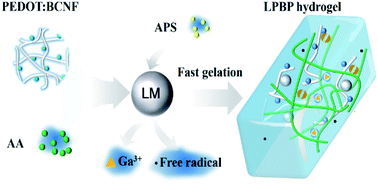Facile gelation of a fully polymeric conductive hydrogel activated by liquid metal nanoparticles†
Abstract
A novel fully polymeric conductive hydrogel was developed based on liquid metal nanoparticle (LMNP) activation and a cross-linked poly(acrylic acid) (PAA) backbone with poly(3,4-ethylenedioxythiophene):sulfonated bacterial cellulose nanofiber (PEDOT:BCNF) nanomaterials as conductive fillers. Activated by LMNPs, the gelation time was much shorter (14–27 seconds) than that of conventional thermal or ultraviolet initiation processes. The resulting conductive hydrogels exhibited ultra-stretchability (2850%), rapid autonomous self-healing and multi-sensory (deformation, solvent and moisture) capabilities. In addition, hydrogels in the initial gelation stage or with a low LM content showed moldability, excellent interfacial adhesion and rapid shape-adaptation. Moreover, LMNPs (or Ga3+) in the matrix endowed the hydrogel with excellent antibacterial properties against the typical Gram-negative bacteria Escherichia coli and Gram-positive bacteria Staphylococcus aureus. In consideration of transparency (thin film), ultra-stretchability, moldability and sensory features, this multifunctional hydrogel may hold promise for applications in wearable devices, force mapping, multiple sensors and patternable electroluminescent devices. This work presented a new concept of conductive PEDOT polymerization using BCNF templates in the construction of conductive hydrogels, providing an effective way to rapidly synthesise multifunctional hydrogels for next-generation green flexible electronics.



 Please wait while we load your content...
Please wait while we load your content...